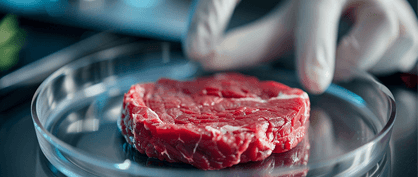From Lab to Table: The Benefits of Lab-Grown Meat

By Dawn Patton Mangine
Humans have been using animals as a food source for millennia. Early humans first domesticated animals in Neolithic times, and modern livestock factory farming began in the United States in the late 19th century. Although the animal products industry has made advancements in the way it delivers meat to our plates, scientists and animal advocates voice concerns about how it is produced, citing both cruelty and sustainability issues.
A new and exciting development in food science may have a positive impact on climate science. More research is needed, but lab-grown meat, also called cell-cultured meat, may be better for the environment than traditional livestock farming.
Climate Impact of Animal Husbandry
Conventional livestock production greatly impacts climate change. The amount of water, land, and grain used, plus the greenhouse gases produced, are harmful to the environment. For example, producing one pound of beef is estimated to use approximately 1,800 gallons of water, including water to grow animal feed, give cows water, and process beef after slaughter.
In comparison, chicken production uses 520 gallons of water per pound; pork, 720 gallons; and soybeans, wheat, and corn between 150 and 250 gallons each, according to the Water Footprint Calculator.
Cows also contribute to the environmental warming because they emit methane gas (in their burps), a major greenhouse gas. Wastewater from farms where they produce meat contains fecal matter and dangerous bacteria like E. coli and Salmonella.
Growing Meat
For about 10 years, scientists have been working on growing meat in a laboratory, and they have been successful on a small scale. Scientists create cell-cultured meat by using stem cells and bioreactors. A bioreactor is a device or system that supports a biologically active environment.
Scientists start with stem cells, which are like building blocks, from an animal. These special cells can develop into many different cell types. In a bioreactor, they develop into muscle, which is the main component of meat. The scientists put the stem cells and necessary nutrients into the bioreactor. The bioreactor helps create a controlled environment with nutrients, water, oxygen, and a consistent temperature.
Over time, the stem cells grow and multiply into muscle tissue. When there is enough material, scientists harvest it, and it’s ready to cook and eat.
This process produces real meat, not a meat-like substance, as with plant-based meat substitutes. The main difference between meat grown in a lab and meat bought at the grocery store is that lab-grown meat doesn’t cause harm or death to animals.
The Future of Food
Although early research indicates that growing meat on a larger scale will not necessarily solve all the climate impacts of conventional livestock farming, there are some advantages. Lab-grown meat eliminates exposure to dangerous bacteria because it doesn’t produce animal waste. While energy usage and output from large-scale bioreactor use may match energy output from beef or pork production, cell-cultured meat will reduce land use and water pollution. Reducing the number of cows will also lower the amount of methane in the environment.
Discussion Questions
- Would you try lab-grown meat? Why or why not?
- What do you think is the best reason for producing lab-grown meat?